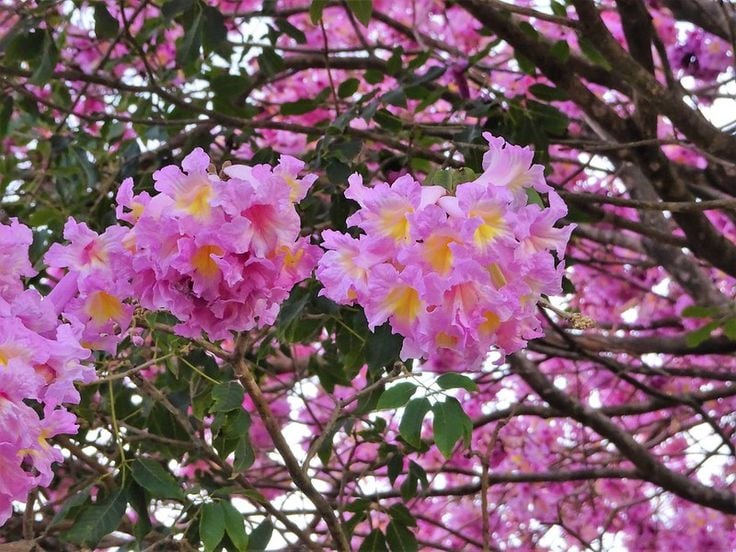Pale Trumpet Tree
by Alicia
6/4/2025


In the heart of Central West Queensland, where dry seasons bite and gardening choices are shaped by resilience, beauty, and practicality, one tree stands out as a worthy contender: Tabebuia pallida, also known as the Pale Trumpet Tree.
🌸 A Showstopper in Bloom
This graceful tree is a cousin of the better-known jacaranda but offers something unique: large, trumpet-shaped flowers in pale pink to white, often with a yellow throat. Blooming just before the flush of new leaves, the Pale Trumpet Tree puts on a stunning display in late summer or early autumn, especially after dry spells.
The flowers aren’t just beautiful—they also support pollinators like bees, butterflies, and honeyeaters, making it a solid choice for wildlife-friendly gardens.


Winton’s gardening climate presents challenges: low rainfall, high summer temperatures, alkaline clay soils, and the occasional frost. Fortunately, Tabebuia pallida has qualities that make it adaptable to our conditions:
✅ Drought Tolerant: Once established, it copes well with dry spells.
✅ Heat Hardy: Grows steadily in hot inland sun.
✅ Low Maintenance: Minimal pruning, few pest issues, and good general resilience.
✅ Non-invasive roots: Safe to plant near structures or paving.
✅ Fast-growing: Reaches 7–10 metres in 5–8 years under good conditions.
🧱 Clay Soil Considerations: Planting in Vertisol
Much of Winton sits on vertisol—black cracking clay that swells when wet and shrinks hard when dry. It can be brutal on young roots, causing poor drainage in the wet and root breakage in the dry.
✅ Soil Prep Tips for Vertisol:
Plant on a mound: Build up a broad, raised mound (30–50cm high) using a mix of topsoil, sand, compost, and gravel to improve drainage and root aeration.
Avoid digging deep holes: Wide and shallow holes are better than deep narrow ones in clay; deep holes can become waterlogged “pots.”
Incorporate gypsum: Blend gypsum (at least 1–2 kg per square metre) into the top 30 cm of soil to help break up clay and improve structure.
Add organic matter: Mix well-rotted compost and coarse sand into the backfill soil to increase porosity and biological activity.
Mulch heavily: Apply a thick (5–10 cm) mulch layer around the base to conserve moisture and reduce surface cracking—but keep it away from the trunk.
These modifications help young roots establish during Winton’s dry winters and reduce stress during summer storms.
🌳 A Perfect Fit for Streetscapes and Yards
Whether you're greening a verge, creating a shade tree near your home, or planting a visual anchor in a rural block, Tabebuia pallida fits the bill. It grows with an upright to spreading habit and doesn’t create the mess or aggressive roots that other large ornamentals do.
Its neat growth and deciduous habit also mean:
Less leaf litter during flowering
Easier mowing or mulching underneath
Seasonal variation that adds interest to your garden
🌍 Sustainable Landscaping in the Outback
As gardeners across the outback embrace low-input, climate-adapted landscapes, species like Tabebuia pallida offer an inspiring blend of beauty, resilience, and ecological value. If you're looking for a small-to-medium tree that brings elegance and colour without fuss, this Caribbean native may be just what your Winton garden needs.
✅ Quick Guide
Feature Details Height 7–15m (typically 10–12m) Spread 4–6m Sunlight Full sun Soil Well-drained (raise in vertisol) Watering Low once established Flowering time Late summer–autumn Wildlife value High – bees, birds, butterflies
Have you tried growing trumpet trees in Winton? I'd love to hear how they've fared in your space. Share your tips, or need guidance on soil prep.
Subscribe to our newsletter
We gratefully acknowledge the Koa people as the traditional custodians of the land on which Ironstone Garden Centre operates. For generations, the Koa people have cared for and nurtured this land, enriching it with their knowledge, culture, and deep connection to Country. We honour their ongoing stewardship and the enduring legacy they have created. As guests on Koa Country, we humbly pay our respects and commit to listening, learning, and working with the Koa community.
